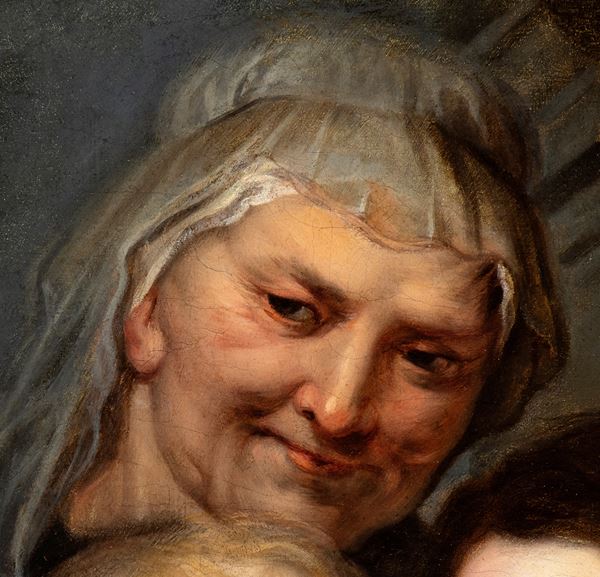164
Peter Paul Rubens (Siegen, 1577 - Anversa, 1640)and help
Holy Family with Saint Anne
Olio su tela
cm. 125x97,5. Whit an ancient frame
The painting is accompanied by the Certificate of Export licence (24/05/2022).
The work is accompanied by a diagnostic report by Prof. Claudio Falcucci (M.I.D.A. - Metodologie d'Indagine per la Diagnostica Artistica) that confirms the compatibility of the pigments used with an execution in the 17th century.
Prof. Niels Buettner had this to say about the painting after personally viewing it: "Its high quality, the structure of the oainting layers and the pigments used suggest that this painting was created in the Rubens workshop. This is my personal estimation." (email communication to owners).
This dazzling depiction of the Holy Family, accompanied by the watchful eye of a smiling St. Anne, constitutes a faithful replica executed by Rubens with the help of his atelier of the canvas that is in all respects similar, except for the slightly larger measurements of our specimen, which is in the Prado Museum in Madrid (cm. 115x90, no. 1639). The Prado painting was chosen by Velzquez for "las salas de los capitulos" at the Escorial and judged in the late 17th century by Padre de los Santos as "Lo mejor que hay en esta Casa al sentir de muchos." The central part of the image with the Virgin seated with the Child standing on her legs, indeed extraordinary in its freshness and serene affection, echoes in many of Rubens' paintings of similar subjects. The Madonna's face seems to take inspiration from Isabel Brandt, the painter's first wife who died at just 35 years old in 1626. The composition was faithfully counter-engraved by Paulus Pontius and then again, but in a redaction with some relevant variations and additions (notably the presence of the cradle), by Schelte Bolswert. A sketch of the composition is preserved in the collection of the Viscounts of Galway.
This dazzling depiction of the Holy Family, accompanied by the watchful eye of a smiling St. Anne, constitutes a faithful replica executed by Rubens with the help of his atelier of the canvas that is in all respects similar, except for the slightly larger measurements of our specimen, which is in the Prado Museum in Madrid (cm. 115x90, no. 1639). The Prado painting was chosen by Velzquez for "las salas de los capitulos" at the Escorial and judged in the late 17th century by Padre de los Santos as "Lo mejor que hay en esta Casa al sentir de muchos." The central part of the image with the Virgin seated with the Child standing on her legs, indeed extraordinary in its freshness and serene affection, echoes in many of Rubens' paintings of similar subjects. The Madonna's face seems to take inspiration from Isabel Brandt, the painter's first wife who died at just 35 years old in 1626. The composition was faithfully counter-engraved by Paulus Pontius and then again, but in a redaction with some relevant variations and additions (notably the presence of the cradle), by Schelte Bolswert. A sketch of the composition is preserved in the collection of the Viscounts of Galway.
The canvas in question stands out for its high quality from other versions produced entirely by the workshop or by close followers of Rubens: we find here, in fact, the unparalleled variety of accents that distinguishes the physiognomies and expressions of his faces, his relentless plastic dominance of the image structure, even in the refined grace and gracefulness of the communicative register, and the brilliant fluidity of the brushstroke that traces the forms with contemptuous ease.
Provenance:
Filangeri di Cutò collection, Palermo; private collection, Italia.
Filangeri di Cutò collection, Palermo; private collection, Italia.
Literature:
D. Bodart, Rubens, Mondadori, Milano 1985, p. 186, n. 658a.
D. Bodart, Rubens, Mondadori, Milano 1985, p. 186, n. 658a.
Live auction 275
Paintings, Drawings and Sculptures from 14th to 19th Century
Palazzo Caetani Lovatelli, thu 23 November 2023
SINGLE SESSION 23/11/2023 Hours 15:00


















